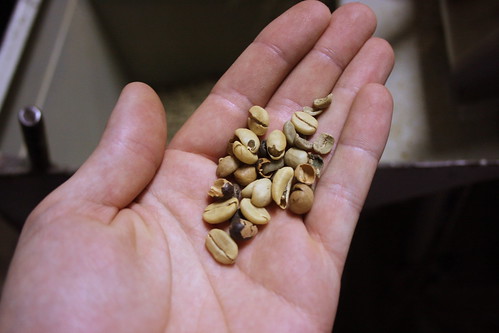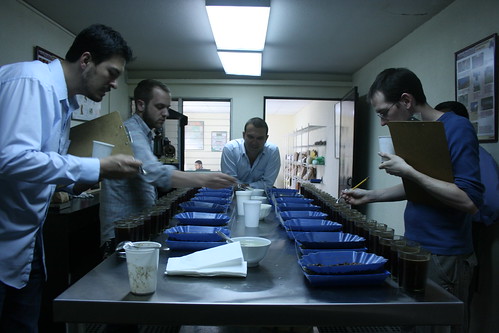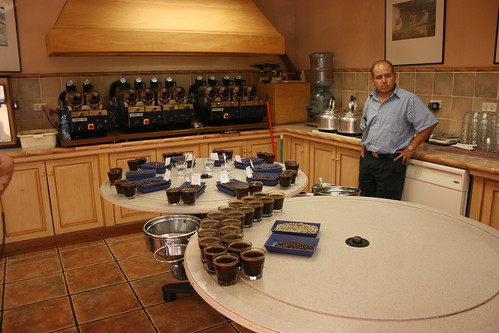So about those Guatemalan coffees.
Earlier this year, we had an interesting venture organized in Guatemala. The idea was to identify three things: 1. Packaging 2. Sorting 3. Distribution
We wanted to know how to get the packing we wanted, the sorting we desired, at the earliest distribution point where we could still control these factors while having access to a large selection of traceable sources.
 That was the idea but it quickly grew into something a bit more complicated. We became pitchmen working to get our brand access in venues which normally only deal in very large volumes. It was a tough sell but we found people willing to listen. Easiest of the three were our sorting requests. While brokers and exporters were either unsure or ambivalent about this request, it really resonated with the mill managers we met. Getting milling to better than a specialty Grade 1 sort with substantially less defects therein justifying us to call it a 'Grade Zero.' After about the third place we visited, we had a clearer idea of how distribution works, how receipts are tracked, who makes decisions, and what the demand is currently on the system. We came across the most interesting idea that sounds stupid simple. There are a lot of great coffees that go through channels we will never see. There are also so many exceptional coffees mixed in large blends that disappear, roasted into oblivion. We need to get at some of those coffees and that became a defining goal.
That was the idea but it quickly grew into something a bit more complicated. We became pitchmen working to get our brand access in venues which normally only deal in very large volumes. It was a tough sell but we found people willing to listen. Easiest of the three were our sorting requests. While brokers and exporters were either unsure or ambivalent about this request, it really resonated with the mill managers we met. Getting milling to better than a specialty Grade 1 sort with substantially less defects therein justifying us to call it a 'Grade Zero.' After about the third place we visited, we had a clearer idea of how distribution works, how receipts are tracked, who makes decisions, and what the demand is currently on the system. We came across the most interesting idea that sounds stupid simple. There are a lot of great coffees that go through channels we will never see. There are also so many exceptional coffees mixed in large blends that disappear, roasted into oblivion. We need to get at some of those coffees and that became a defining goal. I can't think of a better place than Guatemala for this because of the range in micro climate, consistently high elevation, and clean production methods. For all the great coffees in Guatemala, they suffer one problem. The obsession with profile. Way too many people we met were focused on what the profiles should be when our simple goal was to identify the cleanest, sweetest, most aromatic and distinct. There are plenty of classic mineral acidity Guatemalan coffees though there are also so many more profiles that get blended away or devalued for lack of demand that are coffees I would pay money to have kept separate.
I can't think of a better place than Guatemala for this because of the range in micro climate, consistently high elevation, and clean production methods. For all the great coffees in Guatemala, they suffer one problem. The obsession with profile. Way too many people we met were focused on what the profiles should be when our simple goal was to identify the cleanest, sweetest, most aromatic and distinct. There are plenty of classic mineral acidity Guatemalan coffees though there are also so many more profiles that get blended away or devalued for lack of demand that are coffees I would pay money to have kept separate. After tables and tables of coffees, and having lots broken down smaller and smaller, we found coffees we were excited about. I had to leave one behind but found an exceptional aromatic coffee with a floral rose tea like character and another that can only be described as sickly sweet, juicy, and strong aromatics and yet both from the same area. In the end, we are likely to have 5 Guatemalan coffees of which none are really similar.
After tables and tables of coffees, and having lots broken down smaller and smaller, we found coffees we were excited about. I had to leave one behind but found an exceptional aromatic coffee with a floral rose tea like character and another that can only be described as sickly sweet, juicy, and strong aromatics and yet both from the same area. In the end, we are likely to have 5 Guatemalan coffees of which none are really similar.The final bit which was contingent on getting the floral stuff was getting the packaging done. We were hesitant to believe this would happen but after a lot of footwork by Edwin and a bit of luck, we got the sealing together at the last minute. Multiple box designs and time spent testing led to some solid results. They ended up with 19lb vacuum sealed bags in custom cardboard boxes. These are the first coffees exported from Guatemala that are in something other than jute. To which Anacafe gets a big thanks for allowing this to happen and supporting the desire to do this. The result of these efforts is that there is now a way to get vac sealed coffees out of Guatemala be it Cup of Excellence or just something you want to protect.
Work hard to create a demand, do the footwork, and put your money where your mouth is. It may work out or it may not but you have to play it out. I'm happy with how it turned out and I can't wait until the coffees get here. I am already looking at farms to visit, new brokers willing to host, and getting in deeper next year by returning with a larger group of buyers.
